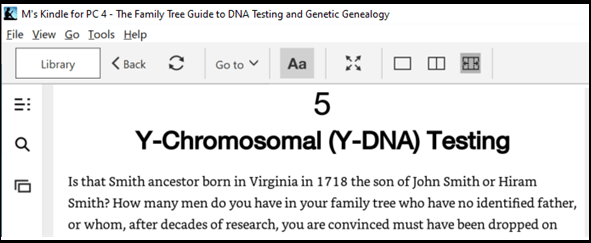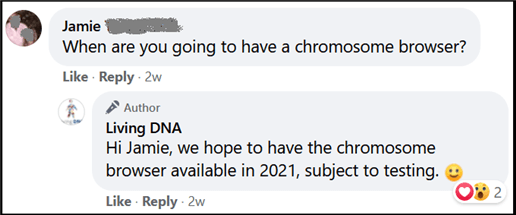This is an in-depth book review of Blaine Bettinger’s Family Tree Guide to DNA Testing and Genetic Genealogy. My conclusion is a hearty recommendation. I have a few quibbles, but its a must-have resource. Be sure to get the latest edition, as the consumer DNA market is constantly changing.
The book is available for purchase on Amazon. If you use the book links on this page, I get a small commission as an Amazon Affiliate.
The Family Tree Guide To DNA Testing and Genetic Genealogy
This is an introductory textbook on using your DNA for family research with the most popular commercial DNA testing companies. Specifically, coverage is given to Ancestry, 23andMe, Family Tree DNA, MyHeritage, and Living DNA.
The early sections aim to give a solid academic grounding to a newcomer to genetic genealogy. Later sections provide how-to guides for different types of DNA tests and the science behind them. The final sections edge into advanced techniques such as chromosome mapping and triangulation.
How Much Do You Need To Know About Genealogy?
The author is looking for a broad audience. Bettinger aims to provide “a resource for genealogists of all experience levels, from beginner to expert and everyone in between.”
I’m a hobby genealogist and I think he’s achieved his aims here. If you’re just getting started on your family tree, you won’t be bamboozled by genealogy jargon.
But that’s the genealogy part, which lends itself to explanation in layperson’s terms. What about the genetics side?
How Much Genetics Do You Need To Know?
Is there a minimum level of scientific knowledge required? The first chapter on “Genetic Genealogy Basics” says that you “don’t even need to remember anything from that biology course you took in the tenth grade.” [the senior school cycle].
I’m not so sure about this assertion. I took a look at some Goodreads reviews, and the vast majority were highly positive (as am I). Yet, there was a smattering of readers who found the science a little difficult to digest.
I, for one, did not breeze through this book. Many sections required a good deal of concentration, but the plentiful diagrams are very helpful.
If you’re unsure, I suggest you take advantage of the “Look Inside” feature of the current Kindle edition. Go ahead and read Chapter 1. The title is “Genetic Genealogy Basics”, but the science is in no way watered down or trivialized.
If you can get through the section on “A Little Genetics – What is DNA”, then that is about the level of complexity you’ll find further along. A furrowed brow is okay!
The subsequent section delves into the difference between the genealogical and genetic family tree. The combination of clearly written explanation supplemented with explanatory diagrams is representative of the rest of the book.
Do You Need This Book If You’ve Self-Taught For a While?
If you’ve worked with your DNA results for a few years, you’ve probably picked up background knowledge from several blogs by genealogists with a strong grasp of genetics. I fell into this category of reading and learning as I worked with my DNA results.
So do you need a book on genetic genealogy? I think that at some point it’s worth getting that scattered knowledge into a broad and structured grounding. I read the book from start to finish in a weekend. Sure, I skimmed certain parts, but I now have a reference to return to when I need more information on a specific topic.
There were entire sections of material that were new to me. Specifically, I had only used autosomal DNA tests when I purchased the book. So, I had a limited grasp of X, Y, and mitochondrial alternatives. There are in-depth chapters on each of these types of tests.
Some time ago, a DNA match on MyHeritage gave me his interpretation of his Y-DNA results from FamilyTreeDNA. Did I mention that I skimmed parts of the book when I first read it? Those were the sections on Y-DNA! Time for a coffee, some chocolate, and Chapter Five.

Do You Get Advanced Techniques?
The main reason I purchased the book was to work with some of the more complex techniques for interpreting DNA results. Specifically, I wanted to get a good understanding of chromosome mapping and triangulation.
This book does not disappoint. Aside from explanatory sections on the concepts, there are specific examples and illustrations of putting various tools to use on your DNA data.
As introductory textbooks go, this one gets pretty far into the weeds of its topics. There is, of course, another level of complexity.
A more advanced testbook was edited by Debbie Parker Wayne and published in 2019. The compendium is squarely aimed at intermediate and advanced researchers. Blaine has also contributed an advanced chapter on visual phasing. “Advanced Genetic Genealogy: Techniques and Case Studies” is available at Amazon.
But the Family Tree Guide provides a great stepping stone to this level. And you may never need to get into the more complex topics.
To give you a flavor of what you get, these are the parts that I particularly enjoyed reading.
Thumbs Up: The Meaty Chapter on Autosomal DNA
If you’ve tested with Ancestry, then this is your type of DNA test. Similarly, you may have taken an atDNA test with 23andMe, Family Tree DNA, MyHeritage, or LivingDNA. Or you may have tested with one of these companies, and transferred your DNA results to others.
This is the chapter that pulls together all those scattered internet searches you’ve done trying to interpret your results.
Recombination, SNPs, minimum segments. You’ve seen the terms but aren’t entirely sure what they mean? This chapter goes step by step through the underlying concepts.
Thumbs Up: Real-life Scenarios of “DNA in Action”
As a professional genealogist, Bettinger can give in-depth case studies on the kinds of mysteries and brick walls that get described and discussed on the DNA forums. These case studies appear in sections called “DNA in Action”.
There’s also a recurring account following the investigation in Britain into the possible remains of King Richard III. Which reminds me to mention that some genealogy books are heavily focused on American examples and sources. In contrast, there’s a good international mix here.
Thumbs Up: Good Coverage of Third-Party Tools
This is what you won’t get from the support pages of the major test companies: coverage of independent third-party tools to supplement your research.
DNA Painter and DNAGedcom are covered with examples and illustrations. An extensive section is given over to GEDmatch.
Thumbs Up: Good Coverage of Adoption and Unknown Parentage
This gets a dedicated chapter. What was new to me was the possibility of using Y-DNA testing (for men) to get some breakthroughs. Bettinger has some detailed case studies on this.
The section on shared matches will be relevant to everyone taking autosomal DNA tests (the most popular type). It’s true that adopted adults will be able to find many helpful online articles on using shared DNA matches in their research. But there’s a good account of how adoptees need to approach shared match triangulation a little differently. And as usual, the chapter works through a practical scenario.
(For additional reading, here’s a link to our article on which DNA tests are best for adoption and unknown parentage).
So those were my “best bits”, and get two thumbs up. And of course, there were other parts of the book for which I had less enthusiasm.
Hit And Miss: “Common Misconceptions”
This critique may just be a personal bugbear! But here goes.
Bettinger presents eleven “misconceptions” in order to provide a robust rebuttal to each one. But to me, some of these misconceptions are far more misconceived than others.
Misconception #1 is “Girls just wanna ha…” eh, no – it’s “Genetic Genealogy is just for fun.” I doubt readers who have purchased a textbook on the subject need convincing.
Misconception #2 is “I’m a woman, so I can’t take a genealogy test myself”. Is that still a popular belief? Seems to me that more women are testing than men. I crunched the gender numbers for my Ancestry DNA matches a few years ago – definitely more women.
We also get (I paraphrase) “the dang government will use my DNA” and “my folks are dead so DNA testing no use to me”.
I was tempted to skip this chapter as being aimed at people with strange notions.
But then at #8 is – and I paraphrase – “my parent has a DNA match, so I should have that match too”. And #9 is “I should share DNA with my genealogical relatives.”
To me, these are assumptions that any reasonable person might draw. And this entire textbook is a detailed explanation of the underlying science that explains why these assumptions are untrue.
I’d throw half the misconceptions into a chapter called “People Say The Darndest Things”. And put the other half into a chapter called “You Need To Know This!”. But that’s just me.
Hit and Miss: Keeping Up To Date With DNA Testing Companies
I understand from other reviews that an earlier edition missed out on MyHeritage altogether. Well, there’s plenty of good coverage for MyHeritage in the latest edition. So be sure to get the latest when purchasing!
But some of the information presented in the latest edition is already out of date. This year, Ancestry raised its segment threshold from six cM to eight. And 23andMe reduced their cap of DNA matches from two thousand to 1.5K.
“A test taker can use the Living DNA chromosome browser to look at shared segments”, says a section dedicated to a tool that simply does not exist.
To be fair, the author does state that “as of this book’s writing, the chromosome browser [for Living DNA customers] is not yet available.” At the time of this review’s writing, two years later, it’s still not available.
I wandered into the company’s Facebook page in October 2020, and didn’t have to search long to find a customer asking forlornly:

I’ve spent decades in the software game. I gotta tell ya, with that kind of phrasing – I wouldn’t advise Jamie to expect the browser to appear before 2022.
I’m sympathetic to the author’s plight. But guessing or gambling is hardly the way to go about the problem of fast-changing commercial software. Perhaps an online errata page could keep track of the latest developments.
Advice: Read On A Laptop Or Tablet Instead Of Your Phone
The plentiful diagrams and illustrations are vital to understanding the concepts. The layout uses color as part of the instruction. And the explanatory labels are quite small.
For those reasons, I’d find it difficult to browse through the book on my phone. And I think the color pictures are needed i.e. a black-and-white viewer would lose clarity.
I used the Kindle app on my laptop to get a decent size. Set the text as wide at it will go, and it’s a great reading experience!
Conclusion – A Best Buy of Genetic Genealogy Books
I have no hesitation in recommending this book to genealogy enthusiasts. You’ll be dipping in and out of it for years to come.
Be sure to get the latest edition available on Amazon. At time of writing, the 2nd edition is the most up-to-date.
Margaret,
I agree with your review.
I think the paper book is for the beginner to intermediate DNA user. Easy to read and logically laid out text with graphics/tables. Ending each chapter with the “Core Concepts” is a great synopsis. I read it when it first came out and have reread it 2 times for book study groups. It is a great teaching aid. I have learned/refocused on new items after each read. Make sure you get the updated edition. The Third-Party Tools and Ethnicity Estimates chapters will always be evolving, but the core chapters will always highlight the basics of genetic genealogy. It is a classic and a good buy.
Paul Baltzer